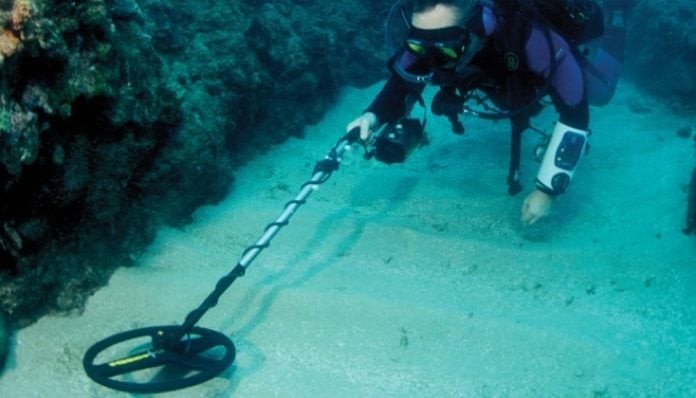Old Spanish coins, Byzantine-era anchors, modern-day wedding rings: some fascinating items have been recovered from watery burials. True, treasure-hunting with a metal detector is most commonly done on land – but there are plenty of detectorists combining their love of diving with a little exploratory adventuring.
Underwater metal detecting can be done in deep or shallow water. Detecting in shallow water requires less specialized equipment, but searching the deeper waters can unearth some amazing, long-forgotten treasures. Last month, a Michigan-area man reported he was “99.9% sure” he had discovered the remains of a 300+ year old French vessel, Le Griffon, the first documented shipwreck in the Great Lakes.
A great many precious artifacts have been deposited across the world from centuries-old shipwrecks. More commonly, recovered items simply fell overboard or were lost around docks. Unfortunately the sea, and even lakes, can be harsh environments and much is lost to the forces of nature. Often, antiquities end up buried by a layer of sediment.
Fresh, cold, dark water is the best environment for the preservation of ships and relics. However, a protective ecosystem is created when these lost objects are buried beneath sediment. After years under the sea, this buffer increases the odds an artifact will survive nature’s wrath.
When it comes to underwater detecting, there are a couple different types of technologies:
- Pulse Induction (PI) detectors are ideal for the ocean. Given the high mineral content of seawater, you need a detector that can cut through the faulty signals and reach to substantial depths.
- Very Low Frequency (VLF) detectors are much more discerning, meaning the machine is less likely to mistake trash for treasure. VLF detectors have the capability to pinpoint coins, jewelry, even gold.
- Look for a machine with a medium-to-large search coil.
- Investing in a sand scoop for easier target recovery would probably be wise.
While valuables are frequently located in shallow water, the big-ticket items are generally found at deeper depths. This is where extremely specialized diving equipment becomes a requirement. Marine salvage, shipwrecks in particular, will require more gear than, say, trying to recover your wedding band with a metal detector. Intensive research is also essential.
If you’re in it for the big win, keep in mind that many of these relics are located at depths safer for ROVs (remotely operated vehicles) than human divers. The unmanned metal detectors are deployed and controlled from your boat and can dive quite deeply without being affected by the pressure level that might hinder human exploration.
Once targets are located, a ‘pinger’ is placed in that area to mark the location for future exploration. Lighting and video equipment are also generally required in order to monitor progress and perform recovery operations effectively.
So what’s your dream find: Sicilian bronze coins, Colonial artifacts, Peruvian silver, 16th-century cannons, a pirate’s blunderbuss? Let your imagination run wild, be careful, and most importantly, have fun out there…


